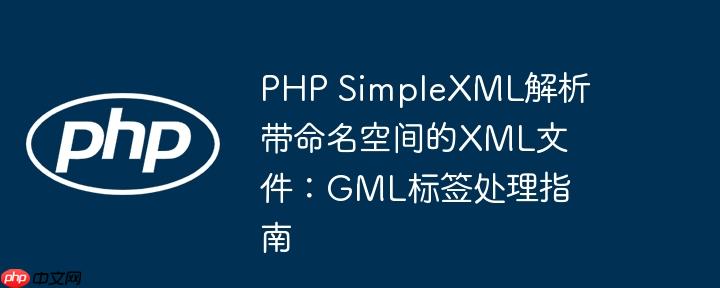
在xml文档中,命名空间(namespace)用于避免元素和属性名称冲突,特别是当文档包含来自不同词汇表的标记时。例如,gml (geography markup language) 标签通常带有 gml: 前缀,如
考虑以下XML结构:
<par xmlns:gml="http://www.opengis.net/gml">
<someOtherTag>Some data</someOtherTag>
<gml:Polygon>
<gml:outerBoundaryIs>
<gml:LinearRing>
<gml:coordinates>
-74.0060,40.7128 -74.0050,40.7138 -74.0040,40.7128 -74.0060,40.7128
</gml:coordinates>
</gml:LinearRing>
</gml:outerBoundaryIs>
</gml:Polygon>
<anotherTag>More data</anotherTag>
</par>如果尝试使用以下代码直接访问 gml:Polygon:
<?php
if (file_exists('doc.xml')) {
$xml = simplexml_load_file('doc.xml');
}
// 尝试直接访问,会导致警告和错误
foreach ($xml->par->{'gml:Polygon'}->{'gml:outerBoundaryIs'}->{'gml:LinearRing'}->{'gml:coordinates'} as $coords) {
echo $coords;
echo '<br>';
}
?>这会产生类似 "Warning: Attempt to read property 'gml:LinearRing' on null" 的错误,因为 $xml->par->{'gml:Polygon'} 无法正确找到对应的元素。解决此问题的关键在于明确告知SimpleXML要处理的命名空间。
SimpleXMLElement对象提供了一个 children() 方法,允许您在遍历子元素时指定命名空间URI。这是处理带命名空间元素的直接方式。
立即学习“PHP免费学习笔记(深入)”;
children() 方法的签名通常是 SimpleXMLElement SimpleXMLElement::children ([ string $ns [, bool $is_prefix = FALSE ]] )。其中 $ns 可以是命名空间URI或前缀(当 $is_prefix 为 TRUE 时)。推荐使用命名空间URI,因为它更具唯一性。
以下是如何使用 children() 方法来正确访问GML标签中的坐标数据:
children($gmlNamespaceURI)->Polygon;
foreach ($gmlPolygons as $polygon) {
// 访问 gml:outerBoundaryIs
$outerBoundaryIs = $polygon->children($gmlNamespaceURI)->outerBoundaryIs;
// 访问 gml:LinearRing
$linearRing = $outerBoundaryIs->children($gmlNamespaceURI)->LinearRing;
// 访问 gml:coordinates
$coordinates = $linearRing->children($gmlNamespaceURI)->coordinates;
echo "Coordinates (using children()): " . (string)$coordinates . "
";
}
} else {
echo "Failed to load XML.";
}
?>这种方法要求您在每次深入访问带命名空间的子元素时都调用 children() 并指定命名空间URI。
对于复杂的XML结构或需要更灵活查询的场景,XPath是更强大的工具。SimpleXML允许您注册命名空间前缀,然后通过 xpath() 方法执行XPath查询。
SimpleXMLElement::registerXPathNamespace(string $prefix, string $ns) 方法用于将一个命名空间前缀映射到其URI。一旦注册,您就可以在XPath表达式中使用该前缀。
registerXPathNamespace('gml', 'http://www.opengis.net/gml');
// 使用 XPath 查询 gml:coordinates
// XPath表达式 '//gml:coordinates' 会查找文档中所有 gml:coordinates 元素
// 更精确的路径: '/par/gml:Polygon/gml:outerBoundaryIs/gml:LinearRing/gml:coordinates'
$coordsNodes = $xml->xpath('//gml:Polygon/gml:outerBoundaryIs/gml:LinearRing/gml:coordinates');
if ($coordsNodes) {
foreach ($coordsNodes as $coords) {
echo "Coordinates (using XPath): " . (string)$coords . "
";
}
} else {
echo "No GML coordinates found.";
}
} else {
echo "Failed to load XML.";
}
?>使用XPath的优点是,您可以通过一个表达式获取深层嵌套的元素,而无需多次调用 children()。这使得代码更简洁,尤其是在处理复杂或可变结构的XML时。
$namespaces = $xml->getNamespaces(true); // 例如,如果 'gml' 命名空间存在,可以通过 $namespaces['gml'] 获取其URI
在PHP中使用SimpleXML解析包含命名空间的XML文件(如GML数据)时,直接通过属性访问 gml:tag 会失败。正确的解决方案是利用SimpleXML提供的 children() 方法指定命名空间URI来逐层访问元素,或者更推荐使用 registerXPathNamespace() 方法注册命名空间,然后结合 xpath() 方法进行灵活而强大的查询。掌握这些技巧,可以有效地从复杂的XML数据中提取所需信息,提升PHP在数据处理方面的能力。
以上就是PHP SimpleXML解析带命名空间的XML文件:GML标签处理指南的详细内容,更多请关注php中文网其它相关文章!

PHP怎么学习?PHP怎么入门?PHP在哪学?PHP怎么学才快?不用担心,这里为大家提供了PHP速学教程(入门到精通),有需要的小伙伴保存下载就能学习啦!

Copyright 2014-2025 https://www.php.cn/ All Rights Reserved | php.cn | 湘ICP备2023035733号